Suwannee River
|
|
The Suwannee River (also spelled Suwanee River) is a major river of southern Georgia and northern Florida in the United States. It is a wild blackwater river, about 266 miles long.
The river rises in the Okefenokee Swamp, emerging at Fargo, Georgia. The river then runs southwest into Florida, dropping in elevation through limestone layers resulting in Florida's only whitewater rapids. It then turns west near White Springs, Florida, receiving the waters of the Alapaha and Withlacoochee Rivers, which together drain much of south-central Georgia. It then bends south near Ellaville, then southeast near Luraville, receives the Santa Fe River from the east just below Branford, then south again to the Gulf of Mexico near the town of Suwannee.
At the time of the Spanish exploration of the area in the 1530s, the river banks were inhabited by the Tumucuan people, who named it Suwani, meaning "Echo River". In the 18th century, Seminoles lived by the river. The steamboat Madison operated on the river before the Civil War, and the sulphur springs at White Springs became popular as a health resort, with 14 hotels in operation in the late 1800s.
This river is the subject of the Stephen Foster song "Old Folks at Home", in which he calls it the Swanee River. Foster had named the Pedee River of South Carolina in his first lyrics, then changed it to Swanee because he thought it sounded better. Foster never saw the river he made world famous. When crossing the river by car today, the sign greeting visitors announces that they are crossing the Historic Suwannee River, complete with the first line of music from the song. "The Old Folks at Home" is the state song of Florida. There is a Foster Museum and Carillon Tower in the state park at White Springs. The spring itself is called White Sulphur Springs because of its high sulphur content.
George Gershwin's "Swanee", made famous by Al Jolson is also inspired by the river.
See also
External links
- USF page with history (http://fcit.usf.edu/florida/lessons/suwannee/suwannee.htm)
- EPA info on Suwannee basin (http://www.epa.gov/owow/showcase/suwaneeriver/location.html)

